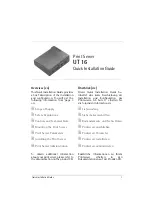
System Components
Hardware Description
2-11
Figure 2-12 Typical Touch Display Panel Connections
Dual Display
Option
A
Dual Display
option (available for Information Centers and Clients) provides for additional
viewing area. With two displays, the
Patient Sectors
of the
Main Screen
appear on the first
display, and patient data review applications and control screens, e.g.
Patient Window
,
All
Controls
menu, etc., appear on the second display. A typical dual display Information Center
. The second display must be ordered separately.
Remote Slave
Displays
The
Remote Slave Display
option is available for both Information Center models and
permits the display of Information Center information at remote locations. Remote display
cable lengths up to 90 m (300 ft.) are supported. The Remote Display is a slave display that
simply displays the window showing on the Philips display it is paired with. Up to 6 Remote
Slave Displays can be connected to an Information Center system using the proper Video
Splitter setup (one 2-way and 6-way) Although no Information Center controls are available
with the remote display, this option can assist clinical users in monitoring patients at other
locations.
Video Splitters
The Remote Slave Display option requires a
Video Splitter
. Both 2-way and 6-way Video
Splitters are available. See
. Remote displays must be ordered separately. A
universal DC power supply is provided for the 2-way Video Splitter. The 6-way Video
USB Cable
Video Cable
Power
Summary of Contents for IntelliVue Series
Page 152: ...IntelliVue Information Center Application Software 3 22 Software Description ...
Page 442: ...Troubleshooting 7 156 Maintenance Troubleshooting and Repair ...
Page 488: ...Procedure B 12 Web Installation on the Database Server ...
Page 492: ...Procedure C 4 External Modem Installation ...
Page 500: ...Using RAS D 8 Dial In Procedure for Remote Access to Information Center Systems ...















































